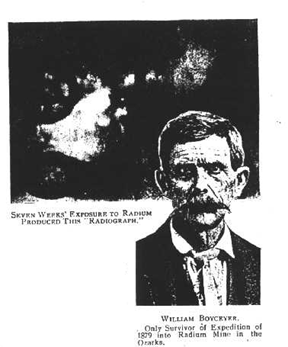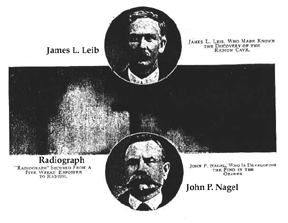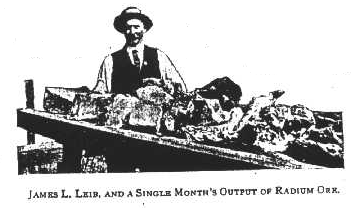One red and gold November day, thirty-three years ago, three Missouri "hill billies" followed their yelping "hound-dog" up a deep mountain canyon in Barry County, Missouri. They were on the trail of a wildcat. When the canyon came to an end, blocked by the face of a rocky cliff, the cat disappeared in the black mouth of an unsuspected cave.
 The hound followed, the hunters waiting outside, their rifles ready. Fifteen minutes later the bay of the dog was heard on the top of the cliff. Plainly the big hole ran clear through the mountain. The hound was whistled down and sent through a second time. Then the four hunters prepared to explore the cavern on their own account.
The hound followed, the hunters waiting outside, their rifles ready. Fifteen minutes later the bay of the dog was heard on the top of the cliff. Plainly the big hole ran clear through the mountain. The hound was whistled down and sent through a second time. Then the four hunters prepared to explore the cavern on their own account.What followed would, in the days of mythology, have added half a dozen monsters to the ranks of the supernatural enemies of mankind. The story is told by old "Bill" Boyceyer, one of the hunters who, after more than thirty years, is now living at Chance, Oklahoma. The events of that November day made such an impression on his mind, that, in an affidavit made last March, he is able to recall them in vivid detail.
"A little way from the mouth of the cave 'Bill' Henry, John Dempsey, and I found what looked to us like rich silver ore. It was growing dusk and we decided to go back to camp, get a good nights rest, and return the next day to make a more careful examination. In the morning we lit our pitch-pine torches and started in. About two hundred feet from the mouth, the cave was partially blocked by what looked like a big tree trunk of solid silver. It was a light peacock blue in color and glittered like diamonds in the glare of our torches. We filled a small box with bits chipped off this pillar of ore, but it was so heavy we could hardly lift it. Finally we went on further into the cave. Nearly five hundred feet from the entrance we entered a big arched room, the walls of which shone like polished silver. Its roof was supported by three transparent, crystal pillars, each about the diameter of a salt-barrel. The floor and part of the walls were a light blue, shimmering mineral. We thought we had found our eternal fortunes. Presently we noticed that when we got on the other side of the crystal pillars, our torches died down and almost went out. We got scared and hurries back to the mouth of the cave. When we reached the open air I fell down in a heap and was not able to move my legs. Henry kneeled over in a sort of faint and Dempsey commenced to talk wild and raving. The boy we had left to wait for us at the cave"s mouth ran for help and finally we were all carried back to the camp."
Henry's condition grew so serious that he was taken to a hospital at Carthage, Mo., where he lay for weeks before recovery. Henry collapsed and sores like burns broke out all over his body. Paralysis finally ended in his death. Henry went back, when he got well, to work his "silver mine" but a quarrel over the title to the land drove him away, after he had blocked up and hidden the mouth of the cave. The story of the strange adventures of the three hunters spread by word of mouth among the Arkansas and Missouri hills and finally became one of the grim traditions of the Ozarks.
When Professor and Madame Curie discovered, in Paris, the wonder-working element, radium, word of its marvels finally penetrated the wilds of the mountains and came to the ears of James L. Leib, a prospector and self-taught geologist who has grown up in the hills about Bentonville and Rogers. He had heard of the death-dealing cave and, at once, associated it with the terrible powers of the new element.
 Hunting up old "Bill" Boyceyer in his Oklahoma home, Leib procured from him directions for finding the lost cavern. Taking the necessary precautions to avoid personal injury he entered its mouth far enough to pick up some bits of the strange bluish ore. From Madame Curie herself, he received directions for making a radiograph, the infallible proof of radioactivity in an ore. With the help of a country photographer in Bentonville, he succeeded in making what appear to be perfectly successful and characteristic radio-photographs, several of which are reproduced herewith. The first were made four years ago and were displayed at the county fairs and apple shows in the Ozark country.
Hunting up old "Bill" Boyceyer in his Oklahoma home, Leib procured from him directions for finding the lost cavern. Taking the necessary precautions to avoid personal injury he entered its mouth far enough to pick up some bits of the strange bluish ore. From Madame Curie herself, he received directions for making a radiograph, the infallible proof of radioactivity in an ore. With the help of a country photographer in Bentonville, he succeeded in making what appear to be perfectly successful and characteristic radio-photographs, several of which are reproduced herewith. The first were made four years ago and were displayed at the county fairs and apple shows in the Ozark country.Samples of the ore were submitted to Prof. A. H. Perdue, State Geologist of Tennessee and former state chemist of Arkansas. By making independent experiments, he succeeded in convincing himself that the samples were highly radioactive and that the discovery of the cave promises great things for the world of science. In the spring of 1912 the section of land in which the cave is located was bought by John P. Nagel of Chicago, who owns several fruit farms in the Ozarks and for some months development work has been under way. The final verdict on the richness of the find awaits returns from a large consignment of the ore which has been sent for analysis to Germany. The tremendous possibilities involved may be judged by the fact that at present, the whole world's supply of radium comes from a single group of mines in Austria, which is owned by the Austrian government and that a gram of pure radium is worth perhaps a hundred times its weight in diamonds.

